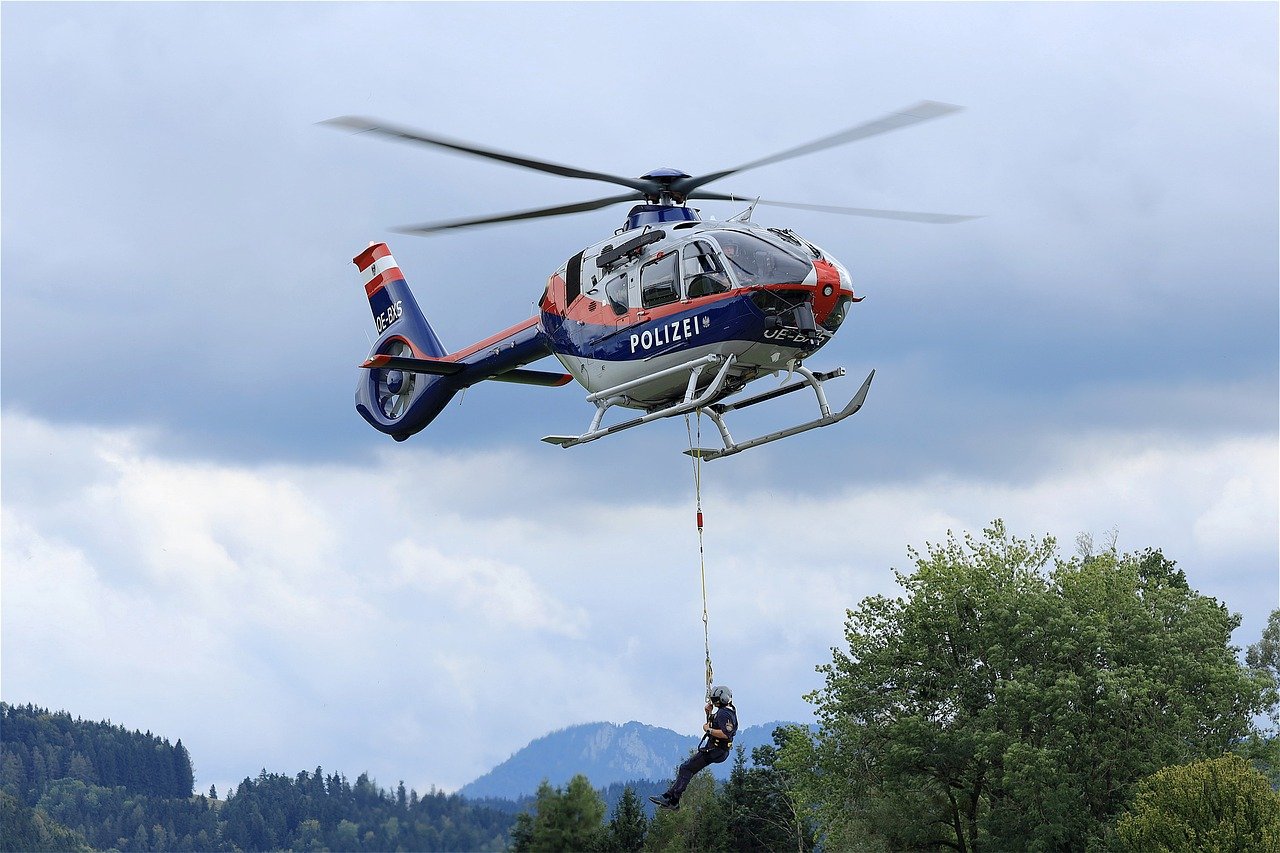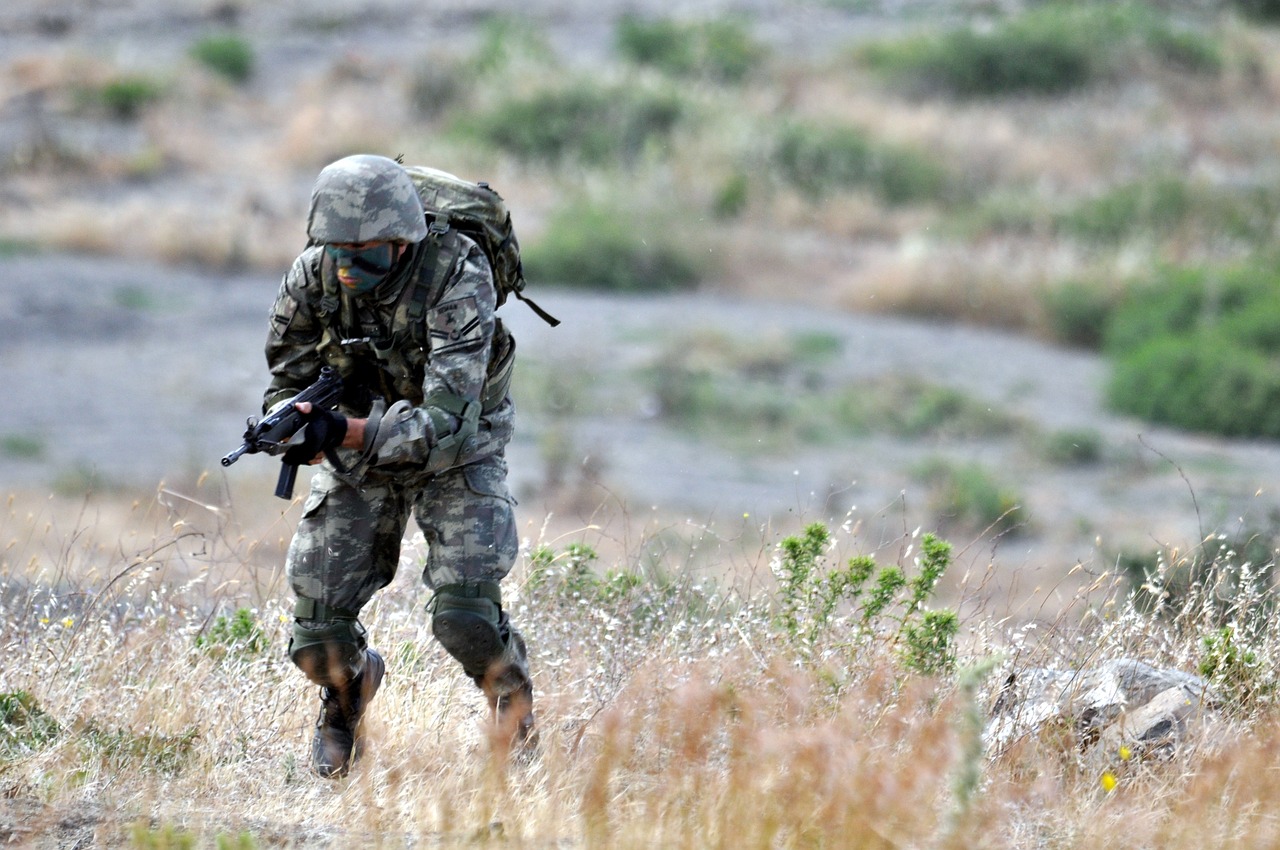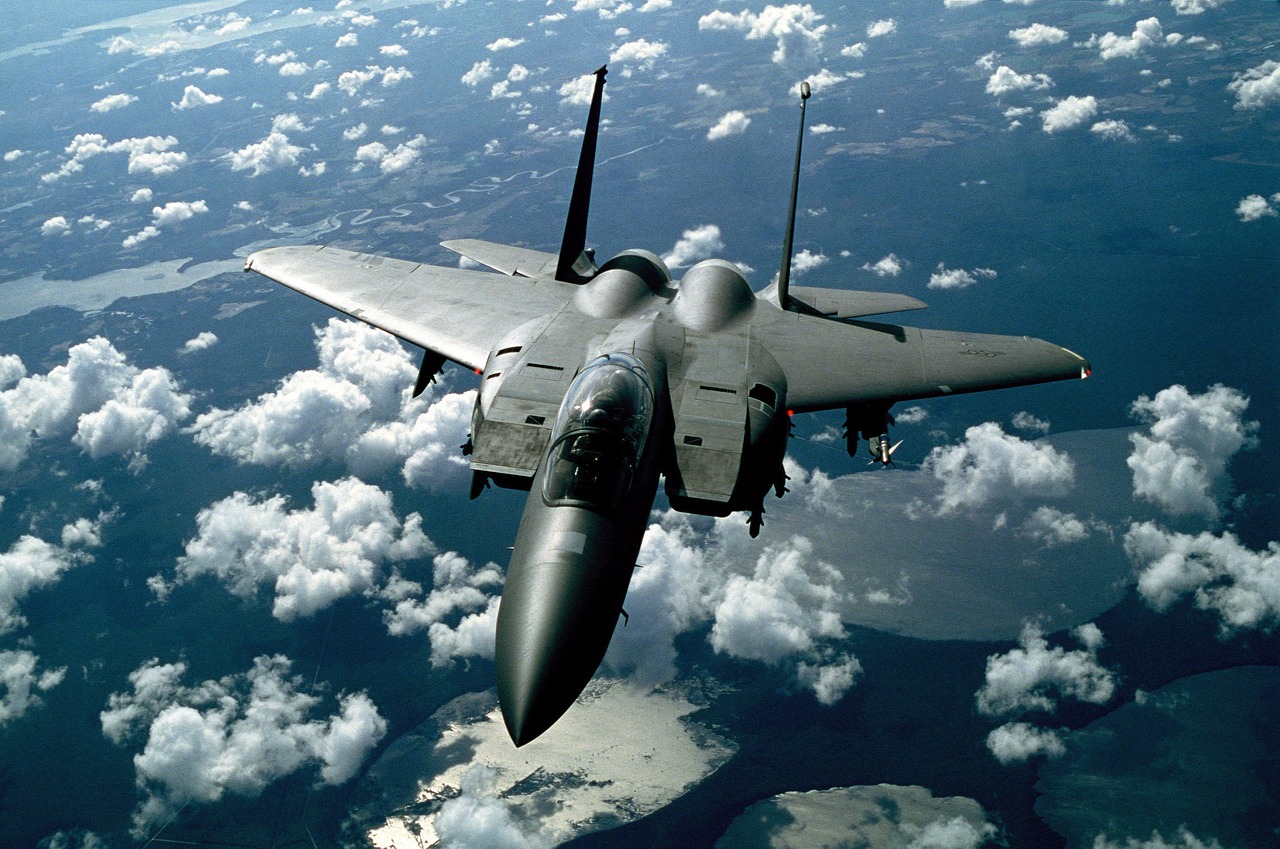Understanding the Benefits of Multi-Domain Operations
In the ever-evolving landscape of military strategy, the concept of multi-domain operations (MDO) has emerged as a game-changer. Imagine a battlefield where forces can seamlessly maneuver across land, air, sea, space, and cyber domains, all working in concert to achieve a unified objective. This is not just a fanciful idea; it's a necessity in today's complex operational environments. The integration of these diverse domains enhances operational effectiveness and adaptability, allowing military forces to respond to threats with unprecedented speed and precision.
So, what exactly are the benefits of multi-domain operations? To put it simply, MDO provides a framework that enhances situational awareness, improves coordination among forces, and increases flexibility in responding to various threats. These advantages are crucial for maintaining a robust defense posture in an era where adversaries are constantly evolving their tactics and technologies.
One of the key benefits of MDO is the ability to foster enhanced situational awareness. By integrating information from multiple sources, commanders can gain a comprehensive understanding of the battlefield. This is akin to having a 360-degree view of the situation, allowing for informed decision-making and rapid responses to evolving threats. Imagine trying to navigate a maze without knowing its layout; that's what traditional operations feel like compared to the clarity provided by multi-domain operations.
Furthermore, MDO significantly improves coordination among forces. In a traditional military framework, different branches may operate in silos, leading to misalignment and inefficiencies. However, with MDO, seamless communication and collaboration become the norm. This integration reduces the risk of miscommunication and increases operational success rates, ensuring that every unit is working toward a common goal. Picture a well-rehearsed orchestra, where each musician plays their part flawlessly, creating a harmonious outcome. That’s the essence of coordinated multi-domain operations.
But it’s not all smooth sailing. Implementing multi-domain operations comes with its own set of challenges. Inter-service coordination can be a significant hurdle, as different branches of the military must overcome institutional barriers and develop a shared understanding of MDO principles. Additionally, technological integration is essential, requiring investments in advanced systems capable of operating across domains and providing real-time data sharing capabilities.
As we look to the future, the potential for multi-domain operations is immense. With ongoing advancements in technology, such as artificial intelligence and autonomous systems, military forces are poised to enhance their capabilities further. These emerging technologies will enable faster decision-making and more effective resource allocation, paving the way for a new era of military strategy.
In conclusion, multi-domain operations represent a transformative approach to modern warfare, offering significant advantages that enhance operational effectiveness and adaptability. As military forces continue to adapt to the complexities of the modern battlefield, embracing MDO will be crucial for maintaining a strategic edge. The future is bright for multi-domain operations, and those who can leverage its potential will undoubtedly shape the outcomes of conflicts to come.
- What are multi-domain operations? Multi-domain operations refer to the integration of land, air, sea, space, and cyber domains into a cohesive military strategy.
- What are the key benefits of multi-domain operations? The key benefits include enhanced situational awareness, improved coordination among forces, and increased flexibility in responding to threats.
- What challenges do military forces face when implementing multi-domain operations? Challenges include inter-service coordination, technological integration, and training personnel to operate effectively across diverse environments.
- How will emerging technologies impact multi-domain operations? Emerging technologies like artificial intelligence and autonomous systems will enhance decision-making speed and resource allocation in multi-domain operations.

The Concept of Multi-Domain Operations
Multi-domain operations (MDO) represent a revolutionary shift in military strategy, integrating various operational domains—land, air, sea, space, and cyber—into a cohesive and synchronized approach. In essence, MDO is about breaking down the silos that traditionally existed between these domains and fostering a holistic view of military engagement. Imagine a symphony orchestra where each musician plays their part in harmony; this is what multi-domain operations aim to achieve on the battlefield. By leveraging the strengths of each domain, military forces can create a more effective and adaptable operational framework.
At its core, MDO enhances operational effectiveness by allowing forces to respond dynamically to emerging threats in a complex and unpredictable environment. The integration of these domains enables a comprehensive understanding of the operational landscape, which is crucial for success in modern warfare. For instance, a ground unit may rely on aerial reconnaissance for real-time intelligence, while naval forces can provide critical support through cyber operations that disrupt enemy communications. This interconnectedness not only improves the effectiveness of individual units but also increases overall mission success rates.
Moreover, the concept of multi-domain operations emphasizes the importance of collaboration and interoperability among different military branches. Each domain has unique capabilities and limitations, and understanding these nuances allows for better coordination. For example, the air force can provide air superiority, while ground forces can secure territories, and cyber units can protect against digital threats. This multi-faceted approach ensures that military operations are not only comprehensive but also adaptable to the ever-changing dynamics of warfare.
To illustrate the various components of MDO, consider the following table:
| Domain | Key Capabilities | Role in MDO |
|---|---|---|
| Land | Infantry, Armor, Artillery | Securing and controlling territory |
| Air | Fighter Jets, Drones, Surveillance | Gaining air superiority and reconnaissance |
| Sea | Naval Ships, Submarines, Amphibious Forces | Projecting power and securing maritime routes |
| Space | Satellites, Space-based Sensors | Communication, navigation, and surveillance |
| Cyber | Network Security, Cyber Warfare | Protecting and disrupting enemy communications |
In conclusion, the concept of multi-domain operations is not just a theoretical framework but a practical approach to modern military strategy. It challenges traditional paradigms and encourages a more integrated and collaborative mindset among military forces. As we move forward, embracing MDO will be essential for maintaining a strategic advantage in an increasingly complex global landscape.
- What are multi-domain operations? Multi-domain operations refer to the integration of land, air, sea, space, and cyber domains into a cohesive military strategy.
- Why are multi-domain operations important? They enhance operational effectiveness, improve situational awareness, and allow for flexible responses to threats.
- What challenges do multi-domain operations face? Challenges include inter-service coordination, technological integration, and training personnel to operate across diverse environments.
- How do emerging technologies impact multi-domain operations? Technologies like artificial intelligence and autonomous systems will enhance decision-making and resource allocation in multi-domain operations.

Strategic Advantages
The strategic advantages of multi-domain operations are not just a matter of military jargon; they represent a transformative shift in how armed forces can effectively engage in modern warfare. Imagine a chess game where each piece has the ability to move across the entire board simultaneously. This is the essence of multi-domain operations, where the integration of land, air, sea, space, and cyber capabilities creates a more dynamic and responsive military strategy. The result? Enhanced situational awareness, improved coordination among forces, and increased flexibility in responding to threats.
One of the standout benefits is enhanced situational awareness. In a complex battlefield, having a clear view of what’s happening across various domains is crucial. Commanders equipped with comprehensive data from multiple sources can make informed decisions swiftly. Picture this: a commander receives real-time intelligence from satellites, drones, and ground forces, all feeding into a central command system. This seamless flow of information allows them to anticipate enemy movements and adjust strategies on the fly, much like a conductor leading an orchestra—every musician playing in harmony to create a powerful symphony.
Moreover, the integration of advanced data techniques is essential for achieving this level of situational awareness. Techniques like data fusion allow for the consolidation of information from disparate sources, creating a unified operational picture. This not only enhances strategic planning but also improves execution on the ground. For instance, a multi-domain task force can leverage insights from cyber operations to inform air and ground strategies, ensuring that all branches are aligned and working towards a common objective.
But it doesn't stop there. The impact on decision-making is profound. Commanders can leverage insights from various domains to anticipate enemy actions and optimize their own strategies. Think of it as having a crystal ball that reveals not just the enemy's next move but also the best counter-strategy. This capability significantly increases the effectiveness of military operations, making it harder for adversaries to predict responses and thus enhancing the element of surprise.
Another significant advantage is the improved coordination among forces. In the heat of battle, miscommunication can lead to catastrophic outcomes. Multi-domain operations facilitate seamless communication and collaboration among different military branches. For example, if air support is needed for ground troops, a well-coordinated multi-domain approach ensures that air assets are deployed without delay, reducing the risk of misalignment and increasing operational success rates. This level of coordination is akin to a well-oiled machine, where every cog and gear works in perfect harmony to achieve a common goal.
In summary, the strategic advantages of multi-domain operations are clear. They provide enhanced situational awareness, improve coordination among forces, and increase flexibility in response to threats. As military strategies evolve, embracing these advantages will be crucial for maintaining a robust defense posture in an increasingly complex global landscape.
- What are multi-domain operations? Multi-domain operations involve the integration of various military domains—land, air, sea, space, and cyber—into a cohesive strategy to enhance operational effectiveness.
- Why is situational awareness important in military operations? Enhanced situational awareness allows commanders to make informed decisions quickly, leading to more effective responses to evolving threats.
- What challenges are faced in implementing multi-domain operations? Challenges include inter-service coordination, technology integration, and training personnel to operate effectively across diverse environments.
- How does technology play a role in multi-domain operations? Advanced technologies enable real-time data sharing and enhance decision-making capabilities across different military domains.

Enhanced Situational Awareness
Multi-domain operations significantly enhance situational awareness, a critical aspect of modern military strategy. In today's complex battlefield, commanders need a clear and comprehensive understanding of their operational environment to make informed decisions. With multi-domain operations, information is not just gathered from one source; it is integrated from various domains such as land, air, sea, space, and cyber. Imagine trying to solve a jigsaw puzzle with only a few pieces—it's nearly impossible to see the whole picture. However, when all pieces are available, the image becomes clear, enabling effective strategies.
This integrated approach allows for a broader view of the battlefield, where real-time data from multiple sources can be analyzed and acted upon swiftly. For instance, if a commander receives intelligence about enemy movements from aerial reconnaissance, they can immediately correlate that data with cyber intelligence indicating potential vulnerabilities in enemy communications. This fusion of information leads to better anticipation of enemy actions and more effective planning.
Moreover, the implementation of advanced data integration techniques plays a vital role in achieving enhanced situational awareness. These techniques enable the seamless sharing of intelligence across different military branches and domains. By employing technologies such as cloud computing and data analytics, military forces can create a unified operational picture, which is crucial for strategic planning and execution. The table below illustrates some key data integration techniques:
| Data Integration Technique | Description |
|---|---|
| Cloud Computing | Facilitates real-time data sharing and storage across multiple platforms. |
| Data Analytics | Analyzes large volumes of data to identify patterns and insights. |
| Artificial Intelligence | Enhances decision-making by providing predictive analytics and automated responses. |
The impact of enhanced situational awareness on decision-making is profound. Commanders equipped with a comprehensive understanding of the battlefield can leverage insights from multiple domains, allowing them to anticipate enemy actions and optimize their own strategies for maximum effectiveness. This capability is akin to having a well-trained chess player who can foresee several moves ahead, making it increasingly difficult for the opponent to gain the upper hand.
In conclusion, enhanced situational awareness through multi-domain operations not only improves decision-making but also ensures that military forces are agile and responsive in the face of rapidly evolving threats. As technology continues to advance, the potential for even greater situational awareness will only increase, further solidifying the importance of this approach in modern military strategy.
- What are multi-domain operations? Multi-domain operations refer to the integration of various military domains—land, air, sea, space, and cyber—into a cohesive strategy to enhance operational effectiveness.
- How does enhanced situational awareness benefit military operations? Enhanced situational awareness provides commanders with a comprehensive understanding of the battlefield, enabling informed decision-making and rapid responses to threats.
- What technologies are involved in improving situational awareness? Technologies such as cloud computing, data analytics, and artificial intelligence are crucial for real-time data integration and analysis across military domains.
- What challenges are faced in implementing multi-domain operations? Challenges include inter-service coordination, technology integration, and training personnel to operate effectively across diverse environments.

Data Integration Techniques
In the realm of multi-domain operations, play a pivotal role in ensuring that military forces can operate effectively across various domains. Imagine a well-coordinated orchestra, where each musician plays their part harmoniously to create a beautiful symphony. Similarly, data integration allows different military branches to share and analyze information in real-time, creating a unified operational picture that enhances strategic planning and execution.
One of the most effective techniques is the use of cloud-based systems, which facilitate the storage and sharing of vast amounts of data across different military branches and domains. These systems enable personnel to access critical information from anywhere, ensuring that decision-makers have the latest intelligence at their fingertips. Additionally, the integration of machine learning algorithms can analyze patterns in data, providing insights that would be impossible to glean through manual processes alone.
Moreover, the incorporation of real-time data feeds from various sensors and platforms allows for a dynamic and responsive approach to operations. For instance, data from satellite imagery, drones, and ground forces can be integrated to provide a comprehensive view of the battlefield. This integration not only enhances situational awareness but also enables commanders to make informed decisions swiftly, adapting to changing circumstances on the ground.
Another crucial aspect of data integration is the establishment of interoperable communication systems. These systems ensure that different military branches can communicate seamlessly, regardless of the technology they use. By standardizing communication protocols and investing in compatible systems, forces can share vital information without the delays that often accompany traditional methods.
To illustrate the significance of these integration techniques, consider the following table that outlines some key data integration methods and their benefits:
| Data Integration Technique | Description | Benefits |
|---|---|---|
| Cloud-Based Systems | Storage and sharing of data across platforms. | Access to real-time information from anywhere. |
| Machine Learning Algorithms | Analyzes data patterns for actionable insights. | Faster decision-making and predictive capabilities. |
| Real-Time Data Feeds | Integrates data from various sources. | Enhanced situational awareness and responsiveness. |
| Interoperable Communication Systems | Standardizes communication across military branches. | Seamless information sharing and reduced delays. |
These data integration techniques not only streamline operations but also enhance the overall effectiveness of military strategies. As we move forward, the importance of advanced data integration will only continue to grow, making it an essential component of successful multi-domain operations.
- What are multi-domain operations? Multi-domain operations refer to the integration of land, air, sea, space, and cyber domains into a cohesive military strategy.
- Why is data integration important in military operations? It enhances situational awareness, improves decision-making, and allows for real-time responses to threats.
- What technologies are used for data integration? Technologies such as cloud systems, machine learning, and interoperable communication systems are crucial for effective data integration.
- How can military forces ensure effective data sharing? By standardizing communication protocols and investing in compatible systems across different branches.

Impact on Decision-Making
The impact of multi-domain operations on decision-making is nothing short of revolutionary. In a world where military engagements can unfold rapidly and unpredictably, having the ability to draw insights from multiple domains—land, air, sea, space, and cyber—empowers commanders to make informed choices swiftly. Imagine being a chess player, but instead of moving pieces on a board, you’re maneuvering assets across various theaters of conflict. The more information you have, the better your strategy becomes, right? This analogy perfectly encapsulates the essence of multi-domain operations.
One of the most significant advantages is the real-time data integration that these operations facilitate. Commanders are no longer limited to a single perspective; they can analyze comprehensive intelligence from various sources simultaneously. This integration allows for a more holistic view of the battlefield, enabling leaders to identify patterns and anticipate enemy actions. For instance, if an airstrike is planned, the commander can assess how ground forces might be affected or how cyber operations could disrupt enemy communications. The synergy between these domains leads to a more robust strategy that can adapt to changing circumstances.
Furthermore, the speed of decision-making is enhanced dramatically. In traditional military operations, the time it takes to gather intelligence, analyze it, and then act can be a significant disadvantage. Multi-domain operations streamline this process, allowing for quicker reactions to threats. The ability to leverage advanced technologies—like artificial intelligence and machine learning—means that data can be processed and analyzed at lightning speed. Imagine having a virtual assistant that not only compiles data but also suggests the best course of action based on historical outcomes and predictive analytics. This capability can be a game-changer in high-stakes scenarios.
However, it’s important to note that the effectiveness of decision-making in multi-domain operations hinges on the quality of the data being collected. Commanders must ensure that the information is accurate, timely, and relevant. Poor data can lead to misguided decisions, which could jeopardize missions and put lives at risk. Therefore, establishing robust data collection and verification processes is essential. This can involve:
- Utilizing advanced sensors and reconnaissance technologies to gather real-time intelligence.
- Implementing rigorous data analysis protocols to ensure information accuracy.
- Training personnel to interpret data effectively and make informed decisions.
In conclusion, the impact of multi-domain operations on decision-making is profound. By providing a comprehensive operational picture, enhancing speed, and ensuring informed choices, these strategies revolutionize how military leaders approach modern warfare. As technology continues to advance, the potential for even greater improvements in decision-making processes is on the horizon, promising a future where military operations are more efficient and effective than ever before.
- What are multi-domain operations? Multi-domain operations involve integrating various military domains—land, air, sea, space, and cyber—into a cohesive strategy for enhanced operational effectiveness.
- How do multi-domain operations improve decision-making? They provide commanders with real-time data from multiple sources, enabling quicker, more informed decisions in response to evolving threats.
- What challenges are associated with implementing multi-domain operations? Challenges include inter-service coordination, technology integration, and training personnel to operate across diverse environments.
- What role do emerging technologies play in multi-domain operations? Technologies like artificial intelligence and autonomous systems enhance decision-making speed and resource allocation in military operations.

Improved Coordination Among Forces
In the fast-paced and ever-evolving landscape of modern warfare, is not just a luxury; it’s a necessity. Imagine a well-orchestrated symphony where each musician plays their part flawlessly, contributing to a harmonious performance. This is precisely the kind of synergy that multi-domain operations strive to achieve among different military branches. By integrating land, air, sea, space, and cyber capabilities, military forces can operate in a more unified and effective manner, significantly enhancing their chances of success on the battlefield.
One of the key aspects of improved coordination is the establishment of seamless communication channels among various units. This requires not only advanced technology but also a cultural shift within military organizations. For instance, when ground troops can communicate in real-time with air support, they can adjust their strategies based on immediate intelligence, leading to quicker and more effective responses to threats. The integration of technologies such as secure communications systems and shared operational platforms is crucial for achieving this level of coordination.
Moreover, training plays a pivotal role in fostering coordination among forces. It’s essential that personnel are not only skilled in their specific domains but also understand the operations of other branches. This cross-training approach can be likened to teaching a basketball player the fundamentals of soccer; while the sports are different, the underlying principles of teamwork and strategy remain the same. By providing joint exercises and simulations, military forces can cultivate a shared understanding and enhance collaborative efforts during real-world operations.
To illustrate the importance of coordination, consider the following table that outlines the benefits of improved inter-force collaboration:
| Benefit | Description |
|---|---|
| Increased Efficiency | Streamlined operations lead to quicker decision-making and resource allocation. |
| Reduced Risks | Minimized chances of miscommunication and friendly fire incidents. |
| Enhanced Adaptability | Ability to respond swiftly to changing battlefield conditions. |
| Holistic Strategy Development | Comprehensive strategies that leverage strengths across all domains. |
In conclusion, the importance of improved coordination among forces cannot be overstated. As military operations become increasingly complex, the ability to collaborate effectively across different domains will determine the success of missions. By investing in technology, fostering a culture of communication, and prioritizing joint training, military forces can create an environment where coordination is not just an objective but a fundamental aspect of their operational ethos.
- What are multi-domain operations? Multi-domain operations involve the integration of various military domains—land, air, sea, space, and cyber—into a cohesive strategy to enhance operational effectiveness.
- Why is coordination among forces important? Improved coordination allows for seamless communication, reduces the risk of misalignment, and increases the overall success rates of military operations.
- What challenges exist in implementing multi-domain operations? Challenges include inter-service coordination, technology integration, and training personnel to operate effectively across diverse environments.
- How can technology improve coordination? Advanced communication systems and real-time data sharing capabilities facilitate better collaboration and informed decision-making among different military branches.

Implementation Challenges
While the benefits of multi-domain operations are clear, implementing these strategies is no walk in the park. The military landscape is complex, and integrating various domains—land, air, sea, space, and cyber—into a cohesive operational framework presents a multitude of challenges. One of the most pressing issues is inter-service coordination. Each branch of the military has its own culture, priorities, and operational methods. This diversity can lead to friction when trying to create a unified approach. Imagine trying to get a bunch of musicians from different genres to play in harmony; it takes time, understanding, and a lot of practice.
Another significant hurdle is technological integration. As military operations become more reliant on advanced technology, there’s a pressing need for systems that can seamlessly operate across different domains. This requires substantial investment in new technologies, as well as the retrofitting of existing systems. For instance, consider how a smartphone integrates various functions—communication, navigation, and even entertainment—into one device. The military is striving for a similar integration, but the stakes are much higher. There’s also the challenge of ensuring that these technologies can share data in real-time, which is crucial for effective decision-making.
Moreover, training personnel to operate effectively across diverse environments is another challenge that cannot be overlooked. Soldiers and commanders must be equipped with the skills to navigate not just the physical battlefield, but also the cyber realm and space. This requires a paradigm shift in how military training is conducted. Instead of focusing solely on traditional combat skills, training programs must now incorporate cyber warfare, space operations, and joint exercises that bring together different branches of the military. It’s akin to teaching a chef not just how to cook, but how to blend flavors from various cuisines to create a unique dish.
In summary, while multi-domain operations promise a more robust defense posture, the path to implementation is fraught with challenges. From bridging the gap between different military branches to ensuring that technology can keep pace with operational needs, the road ahead requires careful planning, investment, and a commitment to overcoming institutional barriers. As the military continues to adapt to the complexities of modern warfare, addressing these implementation challenges will be essential for achieving the full potential of multi-domain operations.
- What are the main challenges of implementing multi-domain operations?
The main challenges include inter-service coordination, technological integration, and training personnel to operate across diverse environments.
- Why is inter-service coordination important?
Inter-service coordination is crucial because different branches of the military must work together seamlessly to execute complex operations effectively.
- How does technology impact multi-domain operations?
Technology plays a vital role by enabling real-time data sharing and operational effectiveness across various military domains.

Inter-Service Coordination
Inter-service coordination is a critical component of successful multi-domain operations. Imagine a symphony orchestra where each musician plays a different instrument; if they don't coordinate, the music will sound chaotic and disjointed. Similarly, in military operations, the various branches—Army, Navy, Air Force, and others—must harmonize their efforts to create a cohesive strategy. This requires overcoming significant institutional barriers that have historically separated these branches, leading to a lack of understanding and collaboration.
One of the primary challenges in achieving effective inter-service coordination is the differing cultures and operational philosophies of each branch. For instance, the Army might prioritize ground maneuvers, while the Air Force focuses on air superiority. These differences can lead to misunderstandings and inefficiencies in joint operations. To bridge this gap, it is essential to foster a culture of collaboration and mutual respect among the services. Regular joint exercises and training programs can help build trust and improve communication, ensuring that all forces are on the same page when it comes to executing multi-domain strategies.
Moreover, establishing clear communication channels is vital for effective coordination. This can be achieved through:
- Joint Command Centers: Creating integrated command structures that include representatives from all branches can facilitate real-time information sharing and decision-making.
- Standardized Protocols: Developing common operational procedures and terminologies can reduce confusion and streamline joint efforts.
- Cross-Training: Encouraging personnel from different branches to train in each other's domains can foster a better understanding of capabilities and limitations.
In conclusion, inter-service coordination is not just a desirable trait; it is a necessity for the successful implementation of multi-domain operations. By breaking down silos, fostering collaboration, and leveraging the unique strengths of each branch, military forces can significantly enhance their operational effectiveness. As we move towards a future where conflicts are increasingly complex and multi-faceted, the ability to coordinate seamlessly across services will be paramount.
Q: What is inter-service coordination?
A: Inter-service coordination refers to the collaboration and communication between different branches of the military to achieve unified operational goals.
Q: Why is inter-service coordination important?
A: It is crucial for the success of multi-domain operations, ensuring that all military branches work together effectively to respond to threats and execute complex strategies.
Q: What are some challenges to inter-service coordination?
A: Challenges include differing cultures among military branches, communication barriers, and the need for standardized protocols.
Q: How can military forces improve inter-service coordination?
A: Through joint training exercises, establishing integrated command centers, and promoting cross-training among personnel from different branches.

Technological Integration
When we talk about multi-domain operations, one of the biggest hurdles we face is . Imagine trying to assemble a complex puzzle where each piece represents a different military domain—land, air, sea, space, and cyber. Each piece must fit together perfectly to create a coherent picture of operational readiness. This integration is not just about having advanced technology; it's about ensuring that all systems can communicate and function together seamlessly.
To achieve this, the military needs to invest heavily in advanced systems that can operate across various domains. These systems must be capable of real-time data sharing, allowing forces to access critical information swiftly. For instance, consider a scenario where a naval fleet detects an incoming threat. If that information can be instantly shared with ground troops and air support, the response can be coordinated more effectively, potentially neutralizing the threat before it escalates. This level of integration is vital for maintaining a competitive edge in modern warfare.
However, integrating technology across domains is fraught with challenges. Different branches of the military often use distinct systems that may not be compatible with one another. To illustrate, let’s take a look at a simplified comparison of the existing technologies across military branches:
| Military Branch | Current Technologies | Integration Needs |
|---|---|---|
| Army | Ground-based radar, drones | Real-time data sharing with air and naval units |
| Air Force | Advanced fighter jets, satellite systems | Linking air surveillance with ground operations |
| Navy | Submarines, aircraft carriers | Integrating naval intelligence with cyber operations |
As we can see from the table, each branch has its own set of technologies, but the real challenge lies in how to make these disparate systems work together. This requires not just technological upgrades but also a cultural shift within the military. Personnel must be trained to understand and utilize these integrated systems effectively. It’s like teaching a group of musicians to play in harmony; each must understand their role and how it fits into the larger composition.
The path to achieving seamless technological integration is paved with obstacles, but the rewards are immense. Enhanced communication and operational efficiency can lead to quicker decision-making and improved outcomes on the battlefield. As emerging technologies continue to develop, the military's focus on integrating these advancements will be crucial for maintaining a strategic advantage.
- What are multi-domain operations? Multi-domain operations refer to the integration of various military domains—land, air, sea, space, and cyber—into a cohesive strategy.
- Why is technological integration important? Technological integration is vital for ensuring that different military branches can communicate effectively and respond to threats in a coordinated manner.
- What challenges does technological integration face? Challenges include compatibility issues between different systems, the need for real-time data sharing, and training personnel to operate across various domains.

The Future of Multi-Domain Operations
The future of multi-domain operations (MDO) is not just a concept; it’s a rapidly evolving reality that promises to redefine how military forces engage in conflicts and respond to emerging threats. As we stand on the brink of technological advancements, the integration of various domains—land, air, sea, space, and cyber—will become increasingly seamless and efficient. Imagine a battlefield where information flows freely between these domains, allowing for real-time decision-making and enhanced operational capabilities. This is the vision of MDO, and it’s closer than we think.
One of the most exciting elements of the future of MDO is the role of emerging technologies. Innovations such as artificial intelligence (AI), machine learning, and autonomous systems are set to revolutionize how military operations are conducted. For instance, AI can analyze vast amounts of data from multiple sources, providing commanders with actionable insights in seconds. This capability will not only speed up decision-making but also enhance the accuracy of operations. Picture a drone equipped with AI that can autonomously adjust its flight path based on real-time threats detected in the airspace—this is the kind of agility that MDO aims to achieve.
Moreover, the integration of cyber capabilities into multi-domain operations will be crucial. As cyber threats become more sophisticated, military forces must be prepared to defend against and counteract these attacks. The future will see a more proactive stance where cyber operations are not just a support function but a core component of military strategy. This shift will require extensive training and a cultural change within the armed forces to ensure personnel are equipped to operate in this complex environment.
Another important aspect of the future of MDO is adapting military doctrine. As the landscape of warfare evolves, so must the strategies and tactics employed by military forces. Adapting military doctrine to fully embrace multi-domain operations is essential for future readiness. This means not only updating training programs but also fostering a mindset that prioritizes collaboration across all domains. The military must cultivate a culture of innovation and flexibility, enabling forces to operate seamlessly in a rapidly changing security landscape.
| Key Areas for Future Development | Description |
|---|---|
| Artificial Intelligence | Utilization of AI for data analysis and decision-making. |
| Cyber Operations | Integration of cyber capabilities as a core military function. |
| Interoperability | Improving collaboration among different military branches. |
| Training and Doctrine | Updating training programs and military doctrine to support MDO. |
In conclusion, the future of multi-domain operations is not merely about technological advancements; it’s about a fundamental shift in how military forces perceive and engage in warfare. As we embrace these changes, the potential for improved operational effectiveness and adaptability becomes limitless. The military landscape is changing, and those who can effectively harness the power of multi-domain operations will undoubtedly have the upper hand in future conflicts.
- What are multi-domain operations? Multi-domain operations involve integrating land, air, sea, space, and cyber capabilities into a cohesive military strategy.
- Why are emerging technologies important for MDO? Emerging technologies like AI and autonomous systems enhance decision-making speed and operational effectiveness.
- How does MDO change military training? MDO requires updated training programs that emphasize collaboration across various military domains.
- What challenges does MDO face? Challenges include inter-service coordination, technology integration, and adapting military doctrine.

Emerging Technologies
The landscape of modern warfare is evolving rapidly, and at the heart of this transformation are . These innovations are not just enhancing existing capabilities; they are fundamentally reshaping how military forces operate across multiple domains. Imagine a battlefield where decisions are made in the blink of an eye, and resources are allocated with pinpoint precision. This is the promise that technologies like artificial intelligence (AI) and autonomous systems bring to the table.
Artificial intelligence, for instance, is revolutionizing data analysis. Commanders can now harness AI to sift through massive amounts of information, identifying patterns and insights that would be impossible for humans to process in real-time. This ability to rapidly analyze data not only improves situational awareness but also enables military leaders to anticipate enemy actions, giving them a strategic edge. Moreover, AI can assist in predictive maintenance of equipment, ensuring that assets are operational when they are needed most.
On the other hand, autonomous systems, including drones and unmanned ground vehicles, are changing the face of reconnaissance and combat. These systems can operate in environments that are too dangerous for human personnel, gathering intelligence and even engaging in combat without risking lives. For example, drones equipped with AI can conduct surveillance missions, relaying real-time information back to command centers, which enhances decision-making speed and effectiveness.
Furthermore, the integration of Internet of Things (IoT) technology into military operations is another exciting development. IoT devices can connect various platforms, enabling seamless communication and data sharing across land, air, sea, and cyber domains. This interconnectedness allows for a more cohesive operational picture, facilitating better coordination among different military branches.
However, with these advancements come challenges. The reliance on technology raises concerns about cybersecurity. As military operations become more dependent on digital systems, the risk of cyberattacks increases. Therefore, it is crucial to invest in robust cybersecurity measures to protect sensitive data and maintain operational integrity.
In conclusion, the integration of emerging technologies into multi-domain operations is not just a trend; it is a necessity for future military effectiveness. As these technologies continue to evolve, they will play a pivotal role in shaping the strategies and capabilities of armed forces around the globe. The future of military operations is undoubtedly intertwined with these innovations, paving the way for a new era of defense strategies that are more responsive, adaptive, and efficient.
- What are multi-domain operations? Multi-domain operations involve the integration of various military domains—land, air, sea, space, and cyber—into a cohesive strategy to enhance operational effectiveness.
- How do emerging technologies impact military strategy? Emerging technologies, such as AI and autonomous systems, improve data analysis, enhance situational awareness, and enable faster decision-making, thereby reshaping military strategies.
- What are the challenges of implementing multi-domain operations? Key challenges include inter-service coordination, technological integration, and training personnel to operate effectively across diverse environments.
- Why is cybersecurity important in multi-domain operations? As military operations increasingly rely on digital systems, robust cybersecurity measures are essential to protect sensitive data and maintain operational integrity.

Adapting Military Doctrine
This article explores the significance of multi-domain operations in modern military strategy, emphasizing its advantages, implementation challenges, and the future of integrated defense systems.
Multi-domain operations refer to the integration of various military domains—land, air, sea, space, and cyber—into a cohesive strategy. This approach enhances operational effectiveness and adaptability in complex environments.
The strategic advantages of multi-domain operations include improved situational awareness, enhanced coordination among forces, and increased flexibility in response to threats. These benefits contribute to a more robust defense posture.
Multi-domain operations foster better situational awareness by providing commanders with comprehensive information from various sources, enabling informed decision-making and rapid responses to evolving threats on the battlefield.
Utilizing advanced data integration techniques allows for real-time sharing of intelligence across domains, facilitating a unified operational picture that enhances strategic planning and execution.
The impact on decision-making is profound, as commanders can leverage insights from multiple domains to anticipate enemy actions and optimize their own strategies for maximum effectiveness.
Improved coordination among forces is crucial for executing complex operations. Multi-domain strategies enable seamless communication and collaboration, reducing the risk of misalignment and increasing operational success rates.
While the benefits are clear, implementing multi-domain operations presents challenges such as inter-service coordination, technology integration, and training personnel to operate effectively across diverse environments.
Inter-service coordination remains a significant hurdle, as different branches of the military must overcome institutional barriers and develop a shared understanding of multi-domain operational principles.
Technological integration is essential for multi-domain operations, requiring investments in advanced systems that can operate across domains and provide real-time data sharing capabilities.
The future of multi-domain operations is promising, with ongoing advancements in technology and strategy. Continued evolution will shape how military forces engage in conflicts and respond to emerging threats.
Emerging technologies, such as artificial intelligence and autonomous systems, will play a vital role in enhancing multi-domain operations, enabling faster decision-making and more effective resource allocation.
Adapting military doctrine to embrace multi-domain operations is crucial for future readiness, ensuring that forces are prepared to operate seamlessly across all domains in a rapidly changing security landscape. This adaptation involves a fundamental shift in how military strategies are conceived and executed. Military leaders must recognize that traditional approaches may no longer suffice in the face of complex, multifaceted threats.
To effectively adapt, military doctrines should incorporate the following key elements:
- Interoperability: Forces from different domains must be trained to work together, sharing information and resources fluidly.
- Flexibility: Doctrines need to allow for rapid adjustments in strategy based on real-time intelligence and battlefield conditions.
- Innovation: Embracing new technologies and methodologies is essential for staying ahead of adversaries.
This transformation is akin to updating an old operating system to run the latest software; it requires a comprehensive understanding of both the new capabilities and the existing framework. As military leaders develop these updated doctrines, they must also engage in continuous training and exercises that simulate multi-domain scenarios. This hands-on experience is invaluable in fostering a culture of adaptability and resilience within military ranks.
Moreover, collaboration with allied forces can enhance understanding and implementation of multi-domain operations. Joint exercises and shared strategies can help establish a unified approach that leverages the strengths of each participating force. In essence, adapting military doctrine is not just about changing policies; it's about cultivating a mindset that is agile, informed, and ready to confront the complexities of modern warfare.
- What are multi-domain operations? Multi-domain operations refer to the integration of land, air, sea, space, and cyber capabilities into a cohesive military strategy.
- Why are multi-domain operations important? They enhance situational awareness, improve coordination among forces, and increase flexibility in responding to threats.
- What challenges exist in implementing multi-domain operations? Key challenges include inter-service coordination, technology integration, and training personnel for diverse environments.
- How can military doctrine adapt to multi-domain operations? By incorporating interoperability, flexibility, and innovation while engaging in continuous training and collaboration with allies.
Frequently Asked Questions
- What are multi-domain operations?
Multi-domain operations involve the integration of various military domains—land, air, sea, space, and cyber—into a unified strategy. This approach enhances operational effectiveness and adaptability, allowing military forces to respond more efficiently to complex threats.
- What are the key benefits of multi-domain operations?
The key benefits include improved situational awareness, enhanced coordination among forces, and increased flexibility in responding to threats. These advantages contribute to a more robust defense posture, ensuring that military operations are more effective and responsive.
- How does multi-domain operations improve situational awareness?
Multi-domain operations enhance situational awareness by providing commanders with comprehensive information from various sources. This real-time data integration allows for informed decision-making and rapid responses to evolving threats on the battlefield.
- What challenges are faced when implementing multi-domain operations?
Implementing multi-domain operations presents several challenges, including inter-service coordination, technological integration, and the need for personnel training to operate effectively across diverse environments. Overcoming these hurdles is essential for successful implementation.
- What role does technology play in multi-domain operations?
Technology is crucial for multi-domain operations as it enables advanced systems to operate across various domains and facilitates real-time data sharing. Investments in emerging technologies are necessary to enhance operational capabilities and improve decision-making processes.
- How will emerging technologies impact the future of multi-domain operations?
Emerging technologies, such as artificial intelligence and autonomous systems, are expected to significantly impact multi-domain operations by enabling faster decision-making, improving resource allocation, and enhancing overall operational effectiveness in future military engagements.
- Why is adapting military doctrine important for multi-domain operations?
Adapting military doctrine is essential for future readiness, as it ensures that forces are prepared to operate seamlessly across all domains. This adaptability is crucial in a rapidly changing security landscape, where threats are increasingly complex and multifaceted.



















